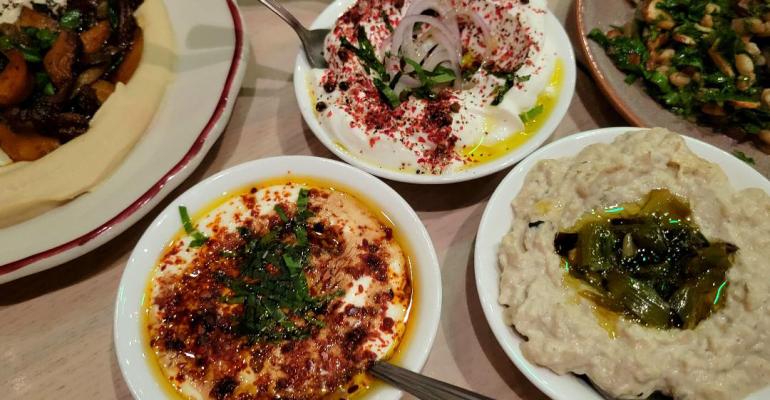The joys of working with labneh have finally hit the mainstream as chefs from across the nation use the thick and creamy yogurt in a variety of dishes. Often labneh can be found in Middle Eastern and some Mediterranean restaurants, but now it's showing up at Italian-influenced hot spots, in New American dishes, and on modern fusion menus.
Historically, labneh has been eaten since the Middle Ages, and in more modern times is a staple mainly in the eastern Mediterranean, including Palestine, Syria, Jordan and Israel. Greek yogurt is strained to give it more heft, and labneh is strained again to make it even richer. Labneh exudes a soft, spreadable cheese consistency, not unlike cream cheese. It often gets smeared onto warm pita and drizzled with fruity olive oil, salt, and za’atar, among other seasonings
"Labneh is like a better version of sour cream, but it has more depth of flavor and a richer texture, and I think everyone can relate to it," said Alon Shaya, who serves homemade labneh at three of his restaurants, Safta in Denver, Saba in New Orleans, and his newest venture, Silan at the Atlantis Casino in the Bahamas.
Adding labneh to his menus proved instinctual given each of those three spots focus on either Israeli or Mediterranean cuisine. Shaya himself grew up having his Bulgarian grandmother, (“safta” is Hebrew for “grandmother”), make it constantly by straining salted yogurt over the sink in a cheese cloth to let the whey separate.
"You can get different textures depending on how long you age it," said the chef over the phone. "The more time you let it sit, the more flavor builds up, so we [at the restaurants] let it sit at room temp and that helps it develop that rich, distinct flavor."
Labneh gets used as a part of the mezze, or appetizer, options and with the pomegranate braised lamb shank at three of Shaya’s restaurants (his fourth, Miss River, does Southern fare). But while traditionally the dip sings with za’atar, sumac, honey, and hot pita, chefs are finding ways to use labneh in other preparations.
For example, at Monteverde in Chicago, chef Sarah Grueneberg, a James Beard Award winner in 2017 for Best Chef: Great Lakes, adds it to her Italian-influenced red kuri squash agrodolce ($18), which also has juniper-smoked ricotta, pomegranate molasses, pumpkin seeds, and dill, and gets served with house-made rye crackers. Gruenberg said she loves labneh for its balanced, creamy tanginess that's not overly acidic or tart.
In North Carolina, chef and owner Joe Kindred of Kindred in Davidson and Hello, Sailor in Cornelius, punches up his labneh with Hatch green chiles and serves it with Korean barbecue-style smoked chicken and smoked shelling peas ($24). That dish was served at Hello, Sailor, and Kindred said he likes using labneh because it's thick and tangy and works as a great vehicle for flavoring fall vegetables.
For Dane Baldwin, chef and owner of The Diplomat in Milwaukee, Wis., incorporating labneh into his New American menu started with root vegetables. Already he made ricotta in house and wanted to find a new way to spruce up his pickled beet salad ($14).
"We tried to find a way to balance the creamy texture with the tang of the pickles, and keep it savory," said Baldwin, a James Beard Award winner in 2022 for Best Chef: Midwest. "The strained yogurt brings a different type of acidity so we combined the ricotta with labneh."
The leftover whey gets used in risotto, and the chef also likes to slather the thick labneh on a piece of fresh sourdough for a personal kitchen snack.
Back in North Carolina, in Raleigh, chef Cheetie Kumar at the Mediterranean restaurant Ajja makes labneh in-house. The key, she said, is to start with well-sourced, full-fat local milk, as well as a simple, two-ingredient yogurt for the base.
"We fold in a nice Spanish Arbequina olive oil with fruity tones and a low tannic finish. It’s not super traditional, but I love our version of labneh," said Kumar, adding that her version has soft, clean flavors and pairs well with everything. "Labneh is prettier than yogurt and it’s great for plating, I like it for its looks and its taste."
At Ajja labneh makes an appearance with the marinated beets ($15), lamb seekh ($23) and in the kuku sabzi ($13), a type of frittata with walnuts, fenugreek and other herbs, and sweet tomato chutney. As a bonus, she added, by making it themselves they have a lot of whey that's used for poaching vegetables, as a braise, and in rice and beans.
In Boulder, Colo., chef Peter Ho of Oak at Fourteenth uses labneh to enhance a fall dish of roasted kabocha squash with pomegranate, mint and hazelnuts. Ho also makes his own labneh, adding seasonings and lemon zest to make it sing with the restaurant’s wood-fired Colorado-American fare, including a recent roasted chicken dish.
As to why so many places have embraced the yogurt-cheese of his childhood, Shaya said a lot has to do with what's popping up on social media. But overall, he added, it's a trend he supports.
"It's the way everything goes right now. The algorithms are taking control and if something gets a lot of ‘likes’ it gets into peoples' heads. Then, when they are writing menus, they are like, ‘let's do labneh,’" he said. "But the more people who break out of their comfort zone, the more they learn and cook delicious food, and that's awesome."





